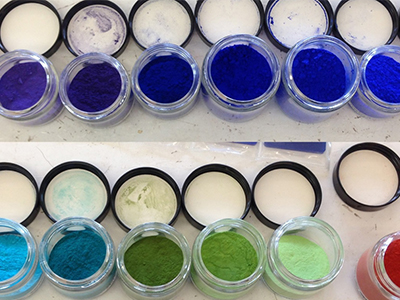New blue pigment for cool Navy coatings

Earlier this year, Defence scientist Chris Lyons travelled to Oregon State University to meet with a team of researchers devoted to the synthesis of new ceramic pigments.
The research aims to provide an entire palette of colours based on a new series of inorganic chemical structures.
Lyons, a researcher and paint formulator, developed the colour-stable low solar-absorbing (LSA) pigment blends which are used in the coatings applied to Royal Australian Navy (RAN) ships. He has a keen interest in the potential use of pigments with different properties when formulated into defence coatings, and his immediate interest will be in evaluating just one of these pigments in the RAN Haze Grey colour.
Brilliant blue breakthrough
In 2009, Oregon State University graduate student Andrew Smith was heating mixtures of different powders to produce new ceramic compounds for electronic applications, when he accidentally discovered a brilliant new blue pigment with high heat stability. When he heated black manganese oxide powder with yttrium and indium to temperatures above 1000°C, a compound with a striking blue colour was pulled from the furnace.
Professor Mas Subramanian, Milton Harris Chair of Materials in the Department of Chemistry at the university, who was a research scientist with DuPont for 22 years, recognised this immediately as an important discovery. "If I hadn't come from an industry research background, I would not have known that this was highly unusual, a discovery with strong commercial potential," Subramanian told Lyons.
Ohio's Shepherd Color Company is licensed to manufacture and commercialise the new blue pigment, which is now widely referred to as "YInMn Blue" (pronounced "yinmin blue"). Lyons has acquired a sample of this pigment from Shepherd and is looking forward to testing it in RAN Haze Grey paint.
A better blue for Haze Grey topcoats for the RAN
Lyons had reformulated the previous RAN colour, Storm Grey, back in 2004, developing a pigment combination which enabled the paint to maintain its colour on exterior exposure to sunlight whilst still giving LSA properties.
However in December 2013, Chief of Navy, Vice Admiral Ray Griggs, announced that the RAN was going to adopt a new fleet colour, Haze Grey, which was determined to be more suitable for the waters around northern Australia. This same colour is employed on the US Navy's fleet. Since the Haze Grey colour was a much bluer shade of grey than Storm Grey, it was obvious to Lyons that he'd need to reformulate the paint. The formulation chosen for Storm Grey employed a highly-stable green pigment, but no blue.
"Fortunately, I had up my sleeve a colour-stable LSA combination using a blue pigment which had been an option for Storm Grey, but was never used for that colour," Lyons says.
"However, by altering the quantities slightly, I knew this particular combination could also be used to formulate the Haze Grey colour, and the formula for doing this has now been licensed to three paint companies.
"The only problem with the blue pigments available at the time I did the work, and which also had the colour stability needed, was that they were all cobalt aluminate based materials.
"These have an absorption band right in the middle of the solar infrared region which detracts somewhat from the LSA properties.
"Another option was to use a copper phthalocyanine pigment, of which there are some excellent grades used for the automotive market.
"These types of pigments give excellent LSA properties when made up into Haze Grey, but tend to break down on exposure and so lead to undesirable colour changes."
The US Navy's Haze Grey paints are formulated with copper phthalocyanine pigments blended with red oxides. When the blue pigment breaks down due to sunlight exposure, a colour dominated by the red oxide develops. In other words, ships gradually turn to a pink hue over time!
"I didn't want that to happen with our ships," says Lyons.
Is this the perfect paint?
When made up into grey-coloured coatings for Navy ship superstructures, colour-stable LSA pigmentations offer significant benefits compared with simple greys based on mixtures of white with black. Some of these benefits include:
- Reduced heat build-up during the day
- Improved living comfort
- Reduced cost of air conditioning
- Colour stability on exposure to sunlight
- Reduced patch-work appearance during maintenance and repair work
- Reduced cost of ownership due to fewer repaints over time
- Reduced thermal signature in the mid- to far-infrared regions
According to Chris Lyons, the interesting thing about the YInMn Blue pigment is that it is the first example of a ceramic blue pigment with the stability properties needed and which also has high reflectance properties right across the solar infrared region.
"This means that we could improve the LSA properties of our RAN Haze Grey paint significantly with this pigment, while maintaining the colour stability we need for Navy," he says.

